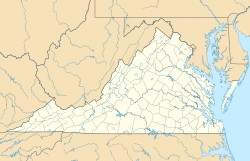Egglestetton | |
 Egglestetton, seen in April 2017 | |
| Location | Northwest of Chula, Chula, Virginia |
|---|---|
| Coordinates | 37°23′52″N77°59′07″W / 37.39778°N 77.98528°W |
| Area | 16 acres (6.5 ha) |
| NRHP reference No. | 80004167 [1] |
| VLR No. | 004-0005 |
| Significant dates | |
| Added to NRHP | March 28, 1980 |
| Designated VLR | June 17, 1975 [2] |
Egglestetton is a historic plantation house located near Chula, Amelia County, Virginia. It was built about 1799, and is a 1+1⁄2-story, five-bay, frame dwelling with a gambrel roof. It has a Central-passage plan and has beaded weatherboard siding. The house was extensively restored in 1972–1973. Also on the property is an early 19th-century kitchen. It was built for planter and Congressman Joseph Eggleston (1754-1811). [3]
It was added to the National Register of Historic Places in 1980. [1]



